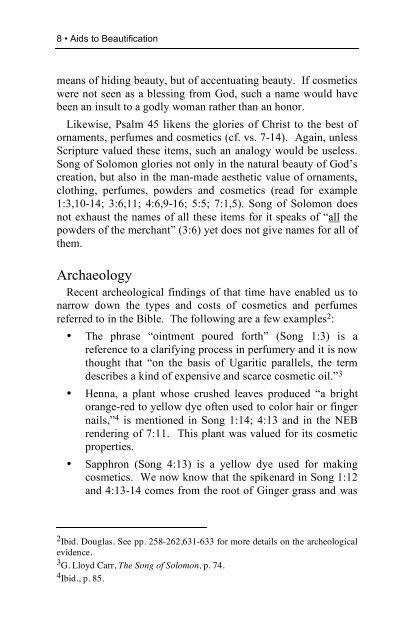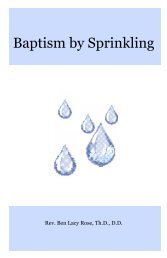Aids to Beautification - Biblical Blueprints
Aids to Beautification - Biblical Blueprints
Aids to Beautification - Biblical Blueprints
You also want an ePaper? Increase the reach of your titles
YUMPU automatically turns print PDFs into web optimized ePapers that Google loves.
8 • <strong>Aids</strong> <strong>to</strong> <strong>Beautification</strong>means of hiding beauty, but of accentuating beauty. If cosmeticswere not seen as a blessing from God, such a name would havebeen an insult <strong>to</strong> a godly woman rather than an honor.Likewise, Psalm 45 likens the glories of Christ <strong>to</strong> the best ofornaments, perfumes and cosmetics (cf. vs. 7-14). Again, unlessScripture valued these items, such an analogy would be useless.Song of Solomon glories not only in the natural beauty of God’screation, but also in the man-made aesthetic value of ornaments,clothing, perfumes, powders and cosmetics (read for example1:3,10-14; 3:6,11; 4:6,9-16; 5:5; 7:1,5). Song of Solomon doesnot exhaust the names of all these items for it speaks of “all thepowders of the merchant” (3:6) yet does not give names for all ofthem.ArchaeologyRecent archeological findings of that time have enabled us <strong>to</strong>narrow down the types and costs of cosmetics and perfumesreferred <strong>to</strong> in the Bible. The following are a few examples 2 :• The phrase “ointment poured forth” (Song 1:3) is areference <strong>to</strong> a clarifying process in perfumery and it is nowthought that “on the basis of Ugaritic parallels, the termdescribes a kind of expensive and scarce cosmetic oil.” 3• Henna, a plant whose crushed leaves produced “a brigh<strong>to</strong>range-red <strong>to</strong> yellow dye often used <strong>to</strong> color hair or fingernails,” 4 is mentioned in Song 1:14; 4:13 and in the NEBrendering of 7:11. This plant was valued for its cosmeticproperties.• Sapphron (Song 4:13) is a yellow dye used for makingcosmetics. We now know that the spikenard in Song 1:12and 4:13-14 comes from the root of Ginger grass and was2 Ibid. Douglas. See pp. 258-262,631-633 for more details on the archeologicalevidence.3 G. Lloyd Carr, The Song of Solomon, p. 74.4 Ibid., p. 85.






